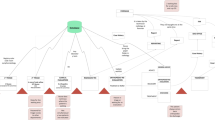Abstract
Background
The decision to optimize the processes in the operating tract was based on two factors: competition among clinics and a desire to optimize the use of available resources. The aim of the project was to improve operating room (OR) capacity utilization by reduction of change and throughput time per patient.
Setting
The study was conducted at Centre Hospitalier Emil Mayrisch Clinic for specialized care (n = 618 beds) Luxembourg (South).
Method
A prospective analysis was performed before and after the implementation of optimized processes. Value stream analysis and design (value stream mapping, VSM) were used as tools. VSM depicts patient throughput and the corresponding information flows. Furthermore it is used to identify process waste (e.g. time, human resources, materials, etc.). For this purpose, change times per patient (extubation of patient 1 until intubation of patient 2) and throughput times (inward transfer until outward transfer) were measured. VSM, change and throughput times for 48 patient flows (VSM A1, actual state = initial situation) served as the starting point. Interdisciplinary development of an optimized VSM (VSM-O) was evaluated. Prospective analysis of 42 patients (VSM-A2) without and 75 patients (VSM-O) with an optimized process in place were conducted.
Results
The prospective analysis resulted in a mean change time of (mean ± SEM) VSM-A2 1,507 ± 100 s versus VSM-O 933 ± 66 s (p < 0.001). The mean throughput time VSM-A2 (mean ± SEM) was 151 min (±8) versus VSM-O 120 min (±10) (p < 0.05). This corresponds to a 23% decrease in waiting time per patient in total.
Conclusion
Efficient OR capacity utilization and the optimized use of human resources allowed an additional 1820 interventions to be carried out per year without any increase in human resources. In addition, perioperative patient monitoring was increased up to 100%.



Similar content being viewed by others
References
Georges ML (2003) Lean Six Sigma for services. Mcgraw-Hill; ISBN: 0-07-141821-0
Trusko E, Pexton C, Harrington HJ, Gupta P (2007) Improving healthcare, quality and cost with Six Sigma. Financial Times Prentice Hall; ISBN: 0-13-174171-3
Nomenclatures des actes et services des medecins et medecins-dentistes. 2008–10:1–68
Rath F (2008) Tools for developing a quality management program: proactive tools (process mapping, value stream mapping, fault tree analysis, and failure mode and effects analysis). Int J Radiat Oncol Biol Phys 71(1 Suppl):S187–190
Wojtys EM, Schley L, Overgaard KA, Agbabian J (2009) Applying lean techniques to improve the patient scheduling process. J Healthc Qual 31(3):10–15, quiz 15–16
Liker JK (2003) The Toyota way. The Mc Graw-Hill Organs; ISBN 007–1392319
Hanss R, Buttgereit B, Tonner PH, Bein B, Schleppers A, Steinfath M, Scholz J, Bauer M (2005) Overlapping induction of anesthesia: an analysis of benefits and costs. Anesthesiology 103(2):391–400
Sandberg WS, Daily B, Egan M, Stahl JE, Goldman JM, Wiklund RA, Rattner D (2005) Deliberate perioperative systems design improves operating room throughput. Anesthesiology 103(2):406–418
Cendán JC, Good M (2006) Interdisciplinary work flow assessment and redesign decreases operating room turnover time and allows for additional caseload. Arch Surg 141(1):65–69, discussion 70
Matern U (2009) Der Experimental OP. Betriebswirtschaft, Patientensicherheit und humanitäre Patientenversorgung sind keine Gegensätze. Der Chirurg BDC 3:149–153
Stepaniak PS, Mannaerts GH, de Quelerij M, de Vries G (2009) The effect of the operating room coordinator’s risk appreciation on operating room efficiency. Anesth Analg 108(4):1249–1256
Sokolovic E, Biro P, Wyss P, Werthemann C, Haller U, Spahn D, Szucs T (2002) Impact of the reduction of anaesthesia turnover time on operating room efficiency. Eur J Anaesthesiol 19(8):560–563
Bauer M et al (2007) Intraoperative Prozesszeiten im prospektiven multizentrischen Vergleich. Dtsch Aerzteblatt 47:A3252–3258
Martin J, Schleppers A, Kastrup M, Kobylinski C, König U, Kox WJ (2003) Entwicklung von Standard Operating Procedures (SOPs) in der Anästhesie und in der Intensivmedizin. Anästh Intensivmed 44:871–876
Stahl JE, Sandberg WS, Daily B, Wiklund R, Egan MT, Goldman JM, Isaacson KB, Gazelle S, Rattner DW (2006) Reorganizing patient care and workflow in the operating room: a cost-effectiveness study. Surgery 139(6):717–728
Mende H (2009) Prozesszeiten in der Anästhesie—Werkzeuge für ein effizientes OP-Management. Anästhesiol Intensivmed Notfallmed Schmerzther 44(7):544–547
Acknowledgment
The valuable assistance of Ms. Lisa Gambhir, MD is highly appreciated.
Conflicts of interest
None.
Author information
Authors and Affiliations
Corresponding author
Additional information
In memoriam: Professor Dr. Jens Witte, 12 June 2003
Rights and permissions
About this article
Cite this article
Schwarz, P., Pannes, K.D., Nathan, M. et al. Lean processes for optimizing OR capacity utilization: prospective analysis before and after implementation of value stream mapping (VSM). Langenbecks Arch Surg 396, 1047–1053 (2011). https://doi.org/10.1007/s00423-011-0833-4
Received:
Accepted:
Published:
Issue Date:
DOI: https://doi.org/10.1007/s00423-011-0833-4




